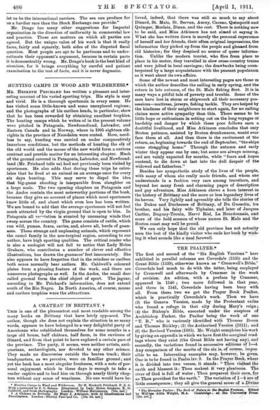HUNTING CAMPS IN WOOD AND WILDERNESS.*
MR. HESKETH PRICHARD has written a pleasant and inter- esting account of his varied sporting trips. His style is easy and vivid. He is a thorough sportsman in every sense. He has visited some little-known and some unexplored regions ; and the photographs of his caribou heads, in particular, show that he has been rewarded by obtaining excellent trophies. The hunting camps which he writes of in the present volume were pitched in Patagonia, Newfoundland, Labrador, and Eastern Canada and in Norway, where in 1905 eighteen elk- rights in the province of Namdalen were rented. Here, need- less to say, bunting was carried on under comparatively luxurious conditions, but the methods of hunting the elk of the old world and the moose of the new world form a curious contrast and provide matter for an interesting chapter. Much of the ground covered in Patagonia, Labrador, and Newfound- land (Mr. Prichard tells us) had not previously been visited by sportsmen. He also adds that during these trips he calcu- lates that he fired at an animal on an average once for every six days hunting. This may serve to dispel the idea that big-game shooting is inseparable from slaughter on a large scale. The two opening chapters on Patagonia and the Andes contain the most noteworthy portions of the book, because they give an account of places which most sportsmen know little of, and about which even less has been written. We are bound to add that the average sportsman will not feel much attracted by the virgin ground that is open to him. In Patagonia all vee..tation is stunted by unceasing winds that sweep across the country. The game consists of cattle, which run wild, pumas, foxes, cavies, and, above all, herds of guan- acos. These strange and unpleasing animals, which represent the camel family in the neo-tropical region, according to our author, have high sporting qualities. The critical reader who is also a zoologist will not fail to notice that Lady Helen Graham, who contributes a number of clever and effective illustrations, has drawn the guanacos' feet inaccurately. She also appears to have forgotten that in the reindeer or caribou both sexes normally bear antlers. Mr. Caldwell's coloured plates form a pleasing feature of the work, and there are numerous photographs as well. In the Andes, the small deer called guemal form the chief object of sport. The jaguar, according to Mr. Prichard's information, does not extend south of the Rio Negro. In North America, of course, moose and caribou trophies were the attractions.










































 Previous page
Previous page